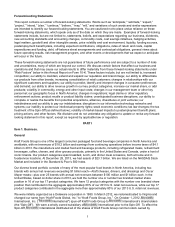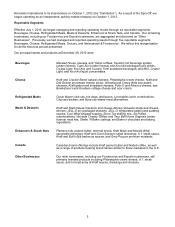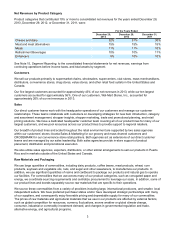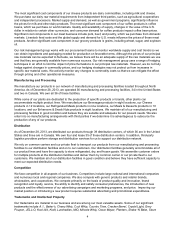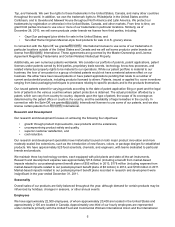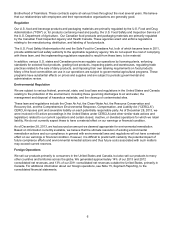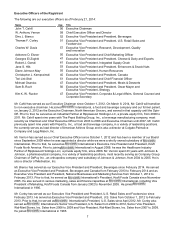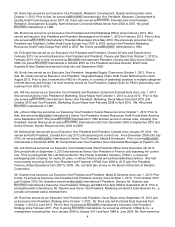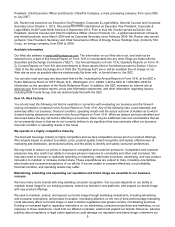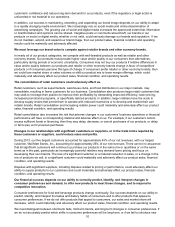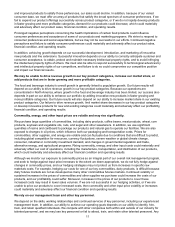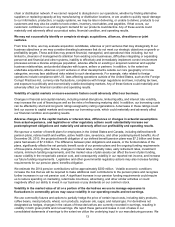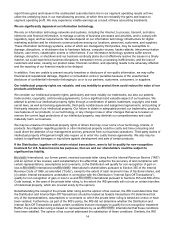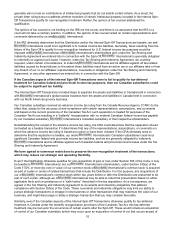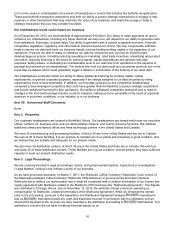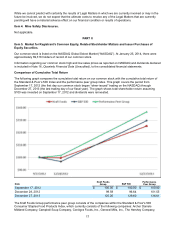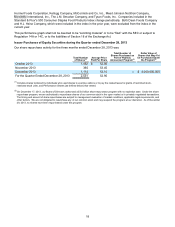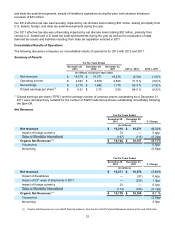Kraft 2013 Annual Report Download - page 13
Download and view the complete annual report
Please find page 13 of the 2013 Kraft annual report below. You can navigate through the pages in the report by either clicking on the pages listed below, or by using the keyword search tool below to find specific information within the annual report.11
and improved products to satisfy those preferences, our sales could decline. In addition, because of our varied
consumer base, we must offer an array of products that satisfy the broad spectrum of consumer preferences. If we
fail to expand our product offerings successfully across product categories, or if we do not rapidly develop products
in faster growing and more profitable categories, demand for our products could decrease, which could materially
and adversely affect our product sales, financial condition, and operating results.
Prolonged negative perceptions concerning the health implications of certain food products could influence
consumer preferences and acceptance of some of our products and marketing programs. We strive to respond to
consumer preferences and social expectations, but we may not be successful in our efforts. Continued negative
perceptions and failure to satisfy consumer preferences could materially and adversely affect our product sales,
financial condition, and operating results.
In addition, achieving growth depends on our successful development, introduction, and marketing of innovative
new products and line extensions. Successful innovation depends on our ability to correctly anticipate customer and
consumer acceptance, to obtain, protect and maintain necessary intellectual property rights, and to avoid infringing
the intellectual property rights of others. We must also be able to respond successfully to technological advances by
and intellectual property rights of our competitors, and failure to do so could compromise our competitive position
and impact our financial results.
We may be unable to drive revenue growth in our key product categories, increase our market share, or
add products that are in faster growing and more profitable categories.
The food and beverage industry’s overall growth is generally linked to population growth. Our future results will
depend on our ability to drive revenue growth in our key product categories. Because our operations are
concentrated in North America, where growth in the food and beverage industry has been limited, our success also
depends in part on our ability to enhance our portfolio by adding innovative new products in faster growing and
more profitable categories. Our future results will also depend on our ability to increase market share in our existing
product categories. Our failure to drive revenue growth, limit market share decreases in our key product categories
or develop innovative products for new and existing categories could materially and adversely affect our profitability,
financial condition, and operating results.
Commodity, energy, and other input prices are volatile and may rise significantly.
We purchase large quantities of commodities, including dairy products, coffee beans, meat products, wheat, corn
products, soybean and vegetable oils, nuts, and sugar and other sweeteners. In addition, we use significant
quantities of resins and cardboard to package our products and natural gas to operate our facilities. We are also
exposed to changes in oil prices, which influence both our packaging and transportation costs. Prices for
commodities, other supplies, and energy are volatile and can fluctuate due to conditions that are difficult to predict,
including global competition for resources, currency fluctuations, severe weather or global climate change,
consumer, industrial or commodity investment demand, and changes in governmental regulation and trade,
alternative energy, and agricultural programs. Rising commodity, energy, and other input costs could materially and
adversely affect our cost of operations, including the manufacture, transportation, and distribution of our products,
which could materially and adversely affect our financial condition and operating results.
Although we monitor our exposure to commodity prices as an integral part of our overall risk management program,
and seek to hedge against input price increases to the extent we deem appropriate, we do not fully hedge against
changes in commodity prices, and our hedging strategies may not protect us from increases in specific raw
materials costs. For example, hedging our costs for one of our key commodities, dairy products, is difficult because
dairy futures markets are not as developed as many other commodities futures markets. Continued volatility or
sustained increases in the prices of commodities and other supplies we purchase could increase the costs of our
products, and our profitability could suffer. Moreover, increases in the prices of our products to cover these
increased costs may result in lower sales volumes. If we are not successful in our hedging activities, or if we are
unable to price our products to cover increased costs, then commodity and other input price volatility or increases
could materially and adversely affect our financial condition and operating results.
We rely on our management team and other key personnel.
We depend on the skills, working relationships and continued services of key personnel, including our experienced
management team. In addition, our ability to achieve our operating goals depends on our ability to identify, hire,
train, and retain qualified individuals. We compete with other companies both within and outside of our industry for
talented personnel, and we may lose key personnel or fail to attract, train, and retain other talented personnel. Any


